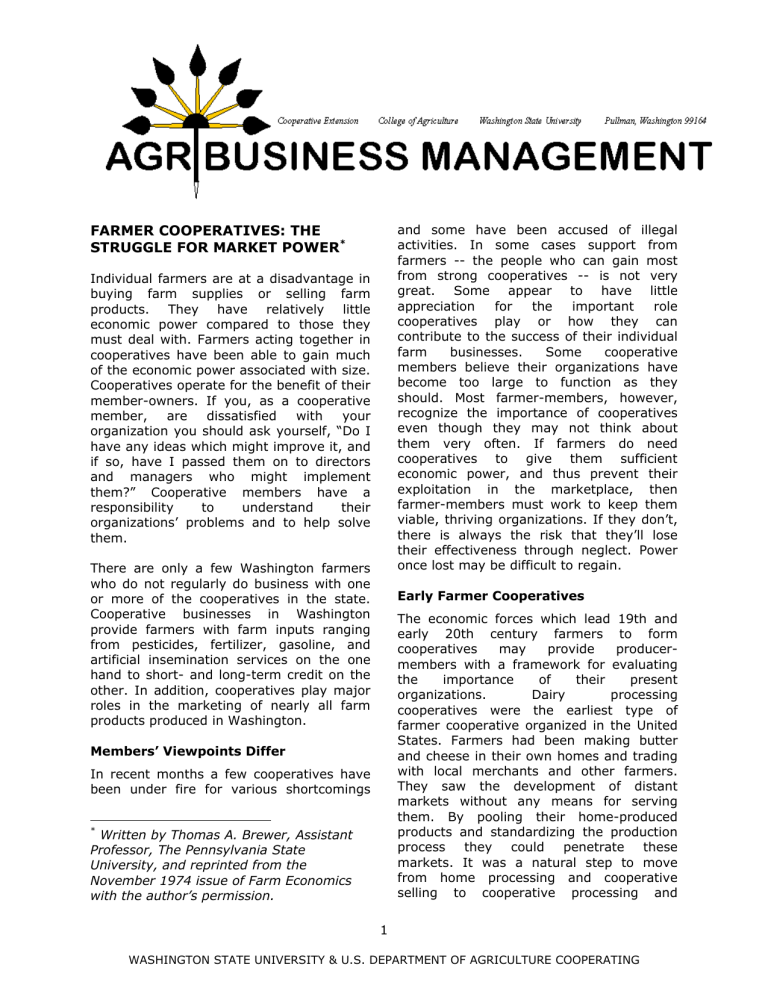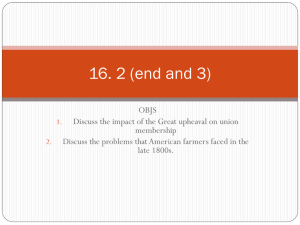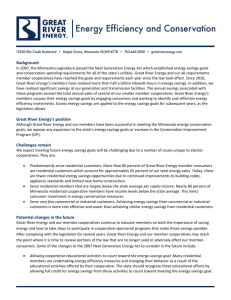FARMER COOPERATIVES: THE STRUGGLE FOR MARKET POWER

FARMER COOPERATIVES: THE
STRUGGLE FOR MARKET POWER
Individual farmers are at a disadvantage in buying farm supplies or selling farm products. They have relatively little economic power compared to those they must deal with. Farmers acting together in cooperatives have been able to gain much of the economic power associated with size.
Cooperatives operate for the benefit of their member-owners. If you, as a cooperative member, are dissatisfied with your organization you should ask yourself, “Do I have any ideas which might improve it, and if so, have I passed them on to directors and managers who might implement them?” Cooperative members have a responsibility to understand their organizations’ problems and to help solve them. products produced in Washington.
Members’ Viewpoints Differ
*
Professor, The Pennsylvania State with the author’s permission.
*
There are only a few Washington farmers who do not regularly do business with one or more of the cooperatives in the state.
Cooperative businesses in Washington provide farmers with farm inputs ranging from pesticides, fertilizer, gasoline, and artificial insemination services on the one hand to short- and long-term credit on the other. In addition, cooperatives play major roles in the marketing of nearly all farm
In recent months a few cooperatives have been under fire for various shortcomings
Written by Thomas A. Brewer, Assistant
University, and reprinted from the
November 1974 issue of Farm Economics and some have been accused of illegal activities. In some cases support from farmers -- the people who can gain most from strong cooperatives -- is not very great. Some appear to have little appreciation for the important role cooperatives play or how they can contribute to the success of their individual farm businesses. Some cooperative members believe their organizations have become too large to function as they should. Most farmer-members, however, recognize the importance of cooperatives even though they may not think about them very often. If farmers do need cooperatives to give them sufficient economic power, and thus prevent their exploitation in the marketplace, then farmer-members must work to keep them viable, thriving organizations. If they don’t, there is always the risk that they’ll lose their effectiveness through neglect. Power once lost may be difficult to regain.
Early Farmer Cooperatives
The economic forces which lead 19th and early 20th century farmers to form cooperatives may provide producermembers with a framework for evaluating the importance of their present organizations. Dairy processing cooperatives were the earliest type of farmer cooperative organized in the United
States. Farmers had been making butter and cheese in their own homes and trading with local merchants and other farmers.
They saw the development of distant markets without any means for serving them. By pooling their home-produced products and standardizing the production process they could penetrate these markets. It was a natural step to move from home processing and cooperative selling to cooperative processing and
1
WASHINGTON STATE UNIVERSITY & U.S. DEPARTMENT OF AGRICULTURE COOPERATING
selling. Centralized processing was more efficient and it improved product marketability because a more consistent quality could be obtained.
Early cooperatives had one thing in common. Farmers pooled resources and their farm products to do a job, which they as individuals couldn’t do. The gaining of market power to insure an equitable sharing of market returns was not then a primary reason for forming cooperatives.
The situation changed during the last thirtyfive years of the 19th century. The westward movement had opened up vast new areas of agricultural land. The devastation of the South’s economy and its society during the Civil War encouraged many to move to the West. A big influx of
European immigrants with agrarian interests led to even more people settling and establishing farms in the Plains states.
Railroads were given grants of land to build transcontinental rail lines. Once built, railroad executives were anxious to haul freight and passengers. They also wanted to achieve returns on their land holdings.
As a result, they encouraged migration westward, which added to the increased agricultural production. Homesteading opportunities also contributed to the growth in agriculture’s productive capacity.
These factors inevitably lead to oversupply of many agricultural commodities. Much of the excessively large harvest was located far from consumers and farmers were dependent upon others to market their products. Many felt that railroads, elevator operators, brokers, and speculators were making too much money and returning too little to the farmer. Farmers who had started business and purchased farms during the war-inflated price years of the
1860’s were trying to pay off these debts with drastically reduced farm-product prices. Overproduction had created a buyer’s market and farmers were not organized to minimize its effects. Grains, for instance, were sold at harvest time to country elevators or terminal warehouses.
Many of these were owned by the railroads.
Rail rates were set by railroads without public regulation. Farmers took what was offered by buyers or left the grain on the farm where the lack of storage facilities or money to build them caused it to spoil. If farmers were to receive more equitable treatment in the marketplace they would have to take over some of the marketing functions themselves. During the 1870’s and through the rest of the century, many cooperative country elevators were organized giving farmers an alternative to selling at harvest. They had gained some market power, but still had a long way to go to achieve equity. During this period, cooperative emphasis changed from horizontal integration to forward or vertical integration. Since that time many cooperatives have had as a major goal the gaining of sufficient market power to assure farmer-members equitable economic treatment.
During the latter part of the 19th century the rural viewpoint was politically dominant in most states and at the federal level.
Many economic conditions which were creating problems for farmers were blamed on developments such as the growth and abuse of the economic power wielded by railroads and others. Toward the end of the century mergers of steel companies and firms in other basic industries concerned much of the public. Various political movements developed. Legislation was proposed and adopted to slow the concentration and prevent some of the abuses from recurring. Interestingly enough, labor felt much the same as agriculture about these giants of industry.
While farmers were forming cooperatives and general farm organizations to combat or gain equality with them, labor was organizing unions. The antitrust laws left marketing cooperatives unsure of their legal status, and made formation of labor unions almost impossible. Federal legislation affecting cooperatives and labor unions was for the most part identical during the period from 1890 to the early 1920’s. From that time each received special legislative attention. Farmer cooperatives and labor
2
unions were attempting to correct what they believed were economic injustices for their members. To be effective, each group had to unite. The antitrust laws were opposed to the uniting of business firms to gain economic power. It took over 30 years of legislation and court actions to differentiate between combinations of farmers or laborers and those of business firms.
Evolution of Anti-Trust Laws
The historical developments of the antitrust laws makes clearer the statue of Farmer
Marketing Cooperatives with respect to these laws.
The public at large was becoming alarmed at the centralization of economic power via mergers and consolidations and the control of large business firms over the economic welfare of so many people. In 1890
Congress passed the Sherman Antitrust
Act. It states in part, “Every contract, combination in the form of trust or otherwise, or conspiracy in restraint of trade or commerce among the several states or with foreign nations is declared to be illegal.” No special note was taken of cooperatives or labor unions.
When the act was under consideration the following amendment was offered and defeated and thus does not appear in the enacted law. “Provided, that this act shall not be construed to apply to any arrangements, agreements or combinations between laborers made with a view of lessening the number of hours of their labor or of increasing their wages nor to any arrangement, agreement, associations or combinations among persons engaged in horticulture or agriculture made with the view of enhancing the price of their own agricultural or horticultural products.” Even at this early date some members of
Congress were recognizing a difference between combinations of business firms and combinations of farmers or laborers.
Failure to include this amendment allowed employers to frustrate the efforts of labor to form unions. The courts backed employers in such actions. Attempts to organize employees were held to be conspiracies in restraint of trade. The courts freely provided restraining orders to prevent continuance of organizing efforts.
Organization of farmers to do business cooperatively was not thwarted to the same degree that labor unions were.
Nevertheless, as larger and larger producer marketing and bargaining associations were formed, the question of how the Sherman
Act might apply to such associations gained the attention of agricultural leaders.
The Clayton Act of 1914 answered the question of whether or not combinations of laborers or farmers could be held to be illegal combinations. Section 6 of the act reads as follows: “The labor of a human being is not a commodity or article of commerce. Nothing contained in the antitrust laws shall be construed to forbid the existence and operation of labor, agricultural or horticultural organizations, instituted for the purposes of mutual help and not having capital stock or conducted for profit or to forbid or restrain individual members of such organizations from lawfully carrying out the legitimate objectives thereof; nor shall such organizations or the members thereof, be held or construed to be illegal combinations or conspiracies in restraint of trade, under the anti-trust laws.”
Labor unions could now organize, but employers responded by forcing employees to sign a contract stating they wouldn't join a union. These were the famed “Yellow
Dog” contracts, which persisted until the
Norris-La Guardia Act made them unenforceable. Labor unions seeking new members found that many had signed this type of contract and thus couldn't join a union. If the union persisted in its organizational efforts with those who had contractually agreed to not join a union it could be charged with “inducing breach of contract.” In such cases courts would issue restraining orders forbidding continuance.
3
Under the Clayton Act, cooperatives did not gain much more than freedom to organize.
The following quotation from an opinion by
The Capper-Volstead Act
The act reads in part: “Be it enacted…that persons engaged in the production of the U.S. Supreme Court helps clarify what
Section 6 of the Clayton Act did for farmer cooperatives. The language of that section
“shows no more than a purpose to allow agricultural products as farmers, planters, ranchmen, dairymen, nut or fruit growers may act together in associations…in collectively processing, preparing for farmers to act together in cooperative associations without the associations as such being held or construed to be illegal combinations or conspiracies in restraint of trade under the antitrust laws as they market, handling and marketing in interstate and foreign commerce, such products of persons so engaged. Such associations may have marketing agencies in common; and such associations and their otherwise might have been.” Farmers and laborers were free to organize but it was unclear what activities, if any, they could legally engage in. The law stated they could members may make the necessary contracts and agreements to affect such purposes: Provided…that such associations are operated for the mutual benefit of the engage in legitimate activities but didn’t explain which of many possible activities were legitimate and which were illegitimate.
Labor unions did not get legislative relief members thereof…” It further requires that no member be allowed more than one vote because of the amount of stock or membership capital he may own or, that from the injunction, which generally made union organizational efforts and activities ineffective until the Norris-La Guardia Act was passed in the early 1930’s. The Wagner
Act in 1935 further enhanced union the association not pay dividends on stock or membership capital at a rate greater than 8 percent per annum if voting on number of shares of stock or volume of business is permitted. In addition it is opportunities for development and growth.
Farmer cooperatives did not have to wait that long. The Capper-Volstead Act of 1922 is the primary federal act, which establishes the status of farmer marketing cooperatives with respect to the antitrust laws. Before the Capper-Volstead Act, it was not clear whether or not farmers combining to form required that every association not deal in the products of nonmembers to such an extent that the value of nonmember products is greater than the value of those handled for members.
The act permits cooperatives to finance their operations with capital stock. Section marketing cooperatives were, at the same time, violating the antitrust laws. The
Capper-Volstead Act authorizes and sanctions the elimination of competition among independent farmers.
It should be observed that the law does not permit cooperatives to operate in ways or indulge in activities, which would be illegal for non-cooperative forms of business. In a sense, all the legislative and court battles were fought to allow farmers and laborers
2 of the act states that the U.S. Secretary of Agriculture, if he has reason to believe that any association monopolizes or restrains trade in interstate or foreign to achieve organizational parity with noncooperative forms of business organizations. The laws do not allow cooperatives to operate any differently than other forms of business. commerce to such an extent that the price of any agricultural product is unduly enhanced, can serve a complaint on the alleged offender and initiate an inquiry into the matter. If, after hearing the evidence, he believes the allegations are true, he may issue a cease and desist order to the cooperative. The cooperative has access to the courts for modification of possible setaside of the order. The Secretary of
Agriculture can petition the court to enforce his order. The Department of Justice enforces the order or its modified version.
Cooperatives were given no special privileges under this law. It simply allowed
4
one group of independent businessmen
(farmers) to act collectively in marketing without fear of prosecution under the antitrust statutes so long as those combinations do not violate the laws as they apply to actions of other business organizations.
Farmers won legislative permission to organize for marketing purposes without fear of being prosecuted under the antitrust laws. They were now free to make their weight felt in the marketplace and obtain more equitable treatment for farmers.
When one remembers that the legislative posture of the country during the late
1800’s and thru the 1920’s was inclined toward the rural point of view, it is surprising the battle was so long and difficult. One can wonder whether or not today’s Congress, with its more urban views, would pass such legislation. The legislation was difficult to achieve but it may be even more difficult to keep. Without it the opportunities afforded farmers to achieve economic equality in the marketplace would be seriously hampered.
Labor appears to be better organized to protect the legislative gains they have achieved.
Is Size Really an Issue?
As early cooperatives organized and took their initial steps into the marketing or farm-supply businesses, they tended to organize on a community basis. Each member of the cooperative knew everyone else and the business, being fairly simple, was easy enough to keep track of. As farmers found it more and more advantageous to increase their involvement in the marketing process and became involved in processing, storing, and distributing consumer products it became necessary for them to develop a larger farm base. They needed a greater volume of agricultural products if they were to penetrate mass markets and do it efficiently. They needed more capital to build facilities and develop markets. In some cases two or more local cooperatives federated to perform these functions and raise the required capital. Some chose other routes. As cooperatives became larger, the frontiers of cooperative decisionmaking became more remote and less well understood by individual cooperative members. Some cooperatives have done an excellent job of keeping members informed and helping them participate in the decision-making process. Others must work on this important area. Some members feel alienated from their cooperatives and feel that they are as unimportant to them as they would be to a large corporation. Size can create such problems.
Nevertheless, when hearing farmers say
“XYZ Cooperative is too big now; it isn’t a cooperative anymore,” one can only wonder whether or not they are simply reflecting a nostalgic longing for the past. Do these farmers want their cooperatives to give up the market power they have attained, or the backward integration to secure control of supplies which may go all the way back to the oil wells and fertilizer deposits in some cases? Upon serious reflection most would probably not want to give up those gains which size has made possible. But they still must feel that they are a part of the organization and an important part they are.
Six cooperatives are now included among
Fortune Magazine’s 500 largest businesses, based upon annual sales. None are very high on that list, but more are on the list than were there ten years ago. Several organizations with which farmers and farmer cooperatives deal are much higher on the list. Does this mean cooperatives are too big? Does it mean they are not yet big enough? Farmers should evaluate their cooperative’s size on the basis of whether or not it is large enough to do the job they expect of it and not on the basis of some irrelevant ranking. Bigger cooperatives mean greater economic power. Bigger cooperatives also require better direction from their boards and better management.
5
Success of a Farmer Cooperative
The successfulness of a cooperative depends upon the same factors as any other business. Sound plans aimed at meeting real demands of those they sell to; efficient operations; adequate financing; carefully thought out procedures and policies spelled out and monitored by a well-trained Board of Directors and translated into action by strong competent management will go a long way toward assuring success. A cooperative differs from other forms of business not in the rules for success but in how the gains from that success are distributed.
Cooperatives and other types of businesses occasionally fail. Failure usually occurs because of a lack of one or more of the ingredients in the above recipe. The business in trouble may have had the problem for years without its surfacing, but eventually such deficiencies come to the forefront. As competition gets more and more intense each of the ingredients gets more critical. A cooperative can be no stronger than its Board of Directors, which in turn can be no stronger than the members who elect them.
Every farmer should ask himself: “If I don’t like the way my cooperative operates do I have any ideas of how it could be improved, and if so, what am I doing to make them known to those in a position to put them into action?”
Ken D. Duft
Extension Marketing Economist
6






